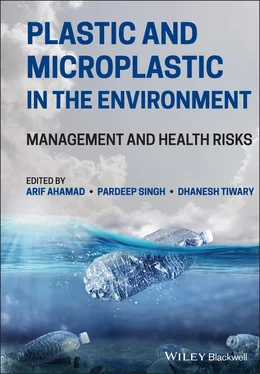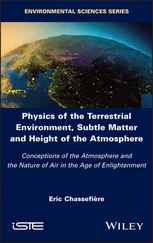Plastic and Microplastic in the Environment
Здесь есть возможность читать онлайн «Plastic and Microplastic in the Environment» — ознакомительный отрывок электронной книги совершенно бесплатно, а после прочтения отрывка купить полную версию. В некоторых случаях можно слушать аудио, скачать через торрент в формате fb2 и присутствует краткое содержание. Жанр: unrecognised, на английском языке. Описание произведения, (предисловие) а так же отзывы посетителей доступны на портале библиотеки ЛибКат.
- Название:Plastic and Microplastic in the Environment
- Автор:
- Жанр:
- Год:неизвестен
- ISBN:нет данных
- Рейтинг книги:5 / 5. Голосов: 1
-
Избранное:Добавить в избранное
- Отзывы:
-
Ваша оценка:
- 100
- 1
- 2
- 3
- 4
- 5
Plastic and Microplastic in the Environment: краткое содержание, описание и аннотация
Предлагаем к чтению аннотацию, описание, краткое содержание или предисловие (зависит от того, что написал сам автор книги «Plastic and Microplastic in the Environment»). Если вы не нашли необходимую информацию о книге — напишите в комментариях, мы постараемся отыскать её.
Thought-provoking discussions of the challenges posed by—and potential solutions to—plastic and microplastic pollution Plastic and Microplastic in the Environment: Management and Health Risks,
Plastic and Microplastic in the Environment
Plastic and Microplastic in the Environment: Management and Health Risks
Plastic and Microplastic in the Environment — читать онлайн ознакомительный отрывок
Ниже представлен текст книги, разбитый по страницам. Система сохранения места последней прочитанной страницы, позволяет с удобством читать онлайн бесплатно книгу «Plastic and Microplastic in the Environment», без необходимости каждый раз заново искать на чём Вы остановились. Поставьте закладку, и сможете в любой момент перейти на страницу, на которой закончили чтение.
Интервал:
Закладка:
Table 1.1 Summary of selected studies on MP contamination in natural freshwater systems.
| Types | Study location | Sampling method | Sample process and analysis | Study finding | References |
|---|---|---|---|---|---|
| Lake water | Taihu Lake, China | Plankton net: 333 μm | H 2O 2(30%); Visual, subset by micro‐FIR or SEM/EDS | Max: 6.8 × 10 6items/km 2Min: 0.1 × 10 6items/km 2 | Su et al. (2016) |
| Lake Hovsgol, Mongolia | Manta trawl: 333 μm | Density separation (saltwater, 1.6 g/cm 3), wet peroxide oxidation; Stereomicroscope (visual), subsample with DSC. | Max: 44 400 items/km 2Mean: 20 264 items/km 2 | Free et al. (2014) | |
| Lake Winnipeg, Canada | Manta trawl: 333 μm | Subsample, wet peroxide oxidation; Visual, subsample with SEM/EDX | Max: 748 000 items/km 2Mean: 193000 items/km 2 | Anderson et al. (2017) | |
| Great Lakes,USA | Manta trawl: 333 μm | Sieved, hydrochloric acid; Subsamples SEM/EDX | Max: 466 000 items/km 2Mean: 43 000 items/km 2 | Eriksen et al. (2013) | |
| Lake Bolsena, Italy | Manta trawl: 300 μm | Sieved, density separation (NaCl, 1.2 g/cm 3), HCl digestion, NR staining. Fluorescence microscopy, SEM. | Max: 4.42 particles/m 3Min: 0.82 particles/m 3 | (Fischer et al. 2016) | |
| Lake Geneva, Switzerland | Manta trawl: 333 μm | Sieved, wet peroxide oxidation; Stereomicroscope (visual), subsample with ATR‐FTIR | Mean: 220 000 items/km 2 | Faure et al. (2015) | |
| River water | Tamar River, UK | Manta trawl: 300 μm | Sieved; ATR‐FTIR and micro‐ FTIR | Max: 204 pieces of suspected plastic Mean: 0.028 items/m 3 | Sadri and Thompson (2014) |
| Ofanto River, Italy | Manta trawl: 333 μm | Sieved, H 2O 2(30%); density separation (salt water, 1.2 g/cm 3), Stereomicroscope (visual), Py–GC/MS | Min: 0.9 items/m 3Max: 13 items/m 3 | Campanale et al. (2020) | |
| Rhine river, Germany, Netherlands, Switzerland | Manta trawl: 300 μm | Enzymatic digestion, density separation (saltwater, 1.2 g/cm 3); Stereomicroscope (visual), ATR‐FTIR. | Max: 8.9 × 10 6items/km 2Mean: 3.9 × 10 6items/km 2 | Mani et al. (2015) | |
| St. Lawrence River, Canada | Grab samples | H 2O 2(30%); density separation, NR staining; Fluorescent microscope | Mean: 0.12 items/L (upstream) Mean: 0.16 items/L (downstream) | Crew et al. (2020) | |
| Los Angeles River, USA | Manta trawl: 333 μm | Sieved. Stereomicroscope (visual) | 9 items/m 3 | Moore et al. (2011) | |
| Pearl River, China | Grab samples | H 2O 2(30%); Stereomicroscope (visual), Raman spectroscopy | Mean: 19860 items/m 3 | Yan et al. (2019) | |
| Yangtze River, China | Manta trawl: 112 μm | Sieved, visually screen, density separation; Stereomicroscope (visual), ATR‐FTIR | Max: 13.6 × 10 6items/km 2Mean: 8.5 × 10 6items/km 2 | Zhang et al. (2015) | |
| Tamsui River, Taiwan | Manta trawl: 300 μm | Sieved, H 2O 2(30%); ATR‐FTIR | Min: 10.1 items/m 3Max: 70.5 items/m 3 | Wong et al. (2020) |
1.6 Conclusions and Recommendations
The number of studies of MP pollution in freshwater environments is growing in the scientific community due to the potential risks to the environment. The results of studies worldwide indicated a high abundance of MPs in freshwater environments. The pollutants were found in all continents of the world, from remote to densely populated areas. Although less data is available, current studies depicted that MPs in freshwater environments are ubiquitous, and concentrations are equivalent to the marine environment. MPs can be discharged into freshwater environments through various pathways such as effluent from WWTPs and during solid waste collection, processing, and landfilling. Therefore, techniques for wastewater treatment and solid waste management need to be improved to mitigate the MP pollution problems. Until now, most studies on MPs in freshwater environments has been conducted in the western hemisphere. Knowledge of the pollutants is insufficient in the other hemispheres such as in South America, Africa, and Asia. Moreover, there are no standard methods for sample collection, preparation, analysis, and reporting of MPs; as a result, data on MPs in freshwater environments cannot be compared easily. This limits further comprehension of MPs and the development of solutions to control the pollutants. Therefore, further studies are required to standardize methods to ensure consistency in monitoring MPs. Furthermore, studies of MPs in freshwater environments need to progress rapidly to fulfill knowledge gaps in the distribution and risks of MP pollution in the environments.
Acknowledgments
This study was funded by the Asia‐Pacific Network for Global Change Research (CRRP2018‐09MY‐Babel). The authors would like to acknowledge a Ph.D. scholarship, provided to the first author by the Thailand Research Fund (PHD/0241/2560).
References
1 Alam, F.C., Sembiring, E., Muntalif, B.S., and Suendo, V. (2019). Microplastic distribution in surface water and sediment river around slum and industrial area (Case study: Ciwalengke River, Majalaya district, Indonesia). Chemosphere 224: 637–645.
2 Anderson, P.J., Warrack, S., Langen, V. et al. (2017). Microplastic contamination in lake Winnipeg, Canada. Environmental Pollution 225: 223–231.
3 Andrady, A.L. (2011). Microplastics in the marine environment. Marine Pollution Bulletin 62: 1596–1605.
4 Andrady, A., Pegram, J., and Searle, N. (1996). Wavelength sensitivity of enhanced photodegradable polyethylenes, ECO, and LDPE/MX. Journal of Applied Polymer Science 62: 1457–1463.
5 Astrom, L. (2016). Shedding of Synthetic Microfibers from Textiles. University of Gotherburg.
6 Bakir, A., O'Connor, I.A., Rowland, S.J. et al. (2016). Relative importance of microplastics as a pathway for the transfer of hydrophobic organic chemicals to marine life. Environmental Pollution 219: 56–65.
7 Ballent, A., Corcoran, P.L., Madden, O. et al. (2016). Sources and sinks of microplastics in Canadian Lake Ontario nearshore, tributary and beach sediments. Marine Pollution Bulletin 110: 383–395.
8 Bergmann, M., Gutow, L., and Klages, M. (2015). Marine Anthropogenic Litter. Springer.
9 Blettler, M.C., Abrial, E., Khan, F.R. et al. (2018). Freshwater plastic pollution: recognizing research biases and identifying knowledge gaps. Water Research 143: 416–424.
10 Browne, M.A., Crump, P., Niven, S.J. et al. (2011). Accumulation of microplastic on shorelines woldwide: sources and sinks. Environmental Science & Technology 45: 9175–9179.
11 Cable, R.N., Beletsky, D., Beletsky, R. et al. (2017). Distribution and modeled transport of plastic pollution in the Great Lakes, the world's largest freshwater resource. Frontiers in Environmental Science 5: 45.
12 Campanale, C., Stock, F., Massarelli, C. et al. (2020). Microplastics and their possible sources: the example of Ofanto river in Southeast Italy. Environmental Pollution 258: 113284.
13 Carr, K.E., Smyth, S.H., McCullough, M.T. et al. (2012). Morphological aspects of interactions between microparticles and mammalian cells: intestinal uptake and onward movement. Progress in Histochemistry and Cytochemistry 46: 185–252.
14 Catarino, A.I., Thompson, R., Sanderson, W., and Henry, T.B. (2017). Development and optimization of a standard method for extraction of microplastics in mussels by enzyme digestion of soft tissues. Environmental Toxicology and Chemistry 36: 947–951.
Читать дальшеИнтервал:
Закладка:
Похожие книги на «Plastic and Microplastic in the Environment»
Представляем Вашему вниманию похожие книги на «Plastic and Microplastic in the Environment» списком для выбора. Мы отобрали схожую по названию и смыслу литературу в надежде предоставить читателям больше вариантов отыскать новые, интересные, ещё непрочитанные произведения.
Обсуждение, отзывы о книге «Plastic and Microplastic in the Environment» и просто собственные мнения читателей. Оставьте ваши комментарии, напишите, что Вы думаете о произведении, его смысле или главных героях. Укажите что конкретно понравилось, а что нет, и почему Вы так считаете.












